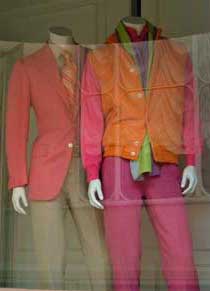
Focus on Capri
1. Introduction
2. Best of Capri
3. Capri town
4. Anacapri
5. Capri hotels
6. Anacapri hotels
7. Hotel ‘A Paziella
8. Hotel Weber Ambassador
About Capri town
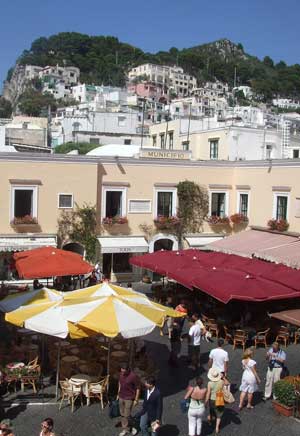
Capri is not just the name of the famed Italian island, but also the name of one of the island’s two towns. Capri town is the most busy and touristy part of the island – this is the Capri of daytrippers and designer-shopping celebrities; the Mediterranean at its most chic. As well as expensive little shops, the town is also full of expensive little hotels, mostly of four and five-star standard. It’s a costly place to stay, but most glamour-seeking travellers prefer it to the island’s other settlements.
The town of Capri is situated on a verdant little plateau – like a saddle – high above the sea. The island’s port, Marina Grande, is connected with the town by funicular, bus and taxi. It is also possible to walk, but it is an uphill slog. Above Capri to the west rises Monte Solaro, the island’s mountain. The other town, Anacapri, is on a higher-level plateau on the mountain’s flank, reached from Capri by a zigzag road up the cliffs.
Apart from one access road, where you’ll find the bus station and taxi rank, Capri is pedestrianised. Luggage, goods and frail locals are transported about on little golf buggies. Hotels can organise porters if you want your baggage transported to or from the port or the funicular station in Capri.
The town centre is a maze of narrow little lanes winding between traditional whitewashed buildings. These lanes can get crowded; it’s helpful to bear in mind that Italians walk on the right. A couple of lanes in the heart of town are lined with shops: jewellery, designer fashion, accessories and one or two more affordable stores (such as Benetton). Walking a little further will take you past cafes and restaurants and out along quieter, bougainvillea-draped lanes which pass exclusive hotels and the private villas of the wealthy.
Things to see in Capri
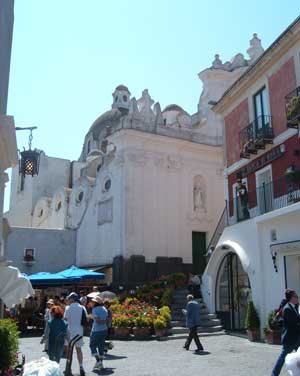
The funicular deposits you alongside a panoramic terrace, with views back down to Marina Grande, and (on a clear day) right over the Bay of Naples. Turning around and walking a few paces will bring you to Capri’s heart, Piazza Umberto I, known to everyone as the Piazzetta (‘little piazza’). The outdoor seating of the expensive cafe-bars is the place to see and be seen in Capri – but don’t sit down if you are on a budget. Up a flight of steps is the town’s pretty church, the Chiesa di Santo Stefano.
Before you explore any further it’s a good idea to acquire a map of the town and to get your bearings. There is a little tourist information desk on the corner of the Piazzetta nearest to the funicular. You don’t necessarily need to visit any ‘tourist attractions’ to appreciate Capri – wandering the lanes and discovering the wonderful island views is enough for most visitors. Many will wish to spend time shopping in the exclusive boutiques and designer stores which line the pretty little lanes.
The best streets for designer fashions are the sloping Via Vittorio Emanuele, which leads down from the Piazzetta to the Grand Hotel Quisisana, another Caprese landmark, and Via Camerelle. You’ll find big name stores like Alberta Ferretti, Versace and Roberto Cavalli along these streets. There is also a branch of Prada on the panoramic terrace close to the funicular. A more varied range of shops, from foodstuffs to shoes, can be found on Via Le Botteghe, through a passage from the Piazzetta. If you want to buy perfume – not forgetting the latest airline baggage restrictions – the place to visit is Carthusia Profumeria (Viale Parco Augusto 2a) for local scents which supposedly originated with the monks of the nearby charterhouse. I was delighted on my last visit to find ‘Capri’-scented room fragrances in 100ml bottles – calculated to fit in your hand luggage.
You shouldn’t miss the stroll out to Punta Tragara, a viewpoint above the Faraglioni rocks, recommended on our Best of Capri page. This is the final stage of a great walk past dramatic coastal features and ruins – see below under ‘Excursions’ – but if you don’t have the time or the energy for the whole walk, just follow Via Tragara out to the headland and then retrace your steps. This is a good way to come if you’re looking for a bench where you can eat a picnic lunch. There’s a drinking-water tap and a stall selling freshly-squeezed fruit juice and granite (refreshing fruit ice-slush) just before the belvedere. Another path winds down to the bathing establishment right by the Faraglioni – but you’ll need to be tough for the walk back uphill.
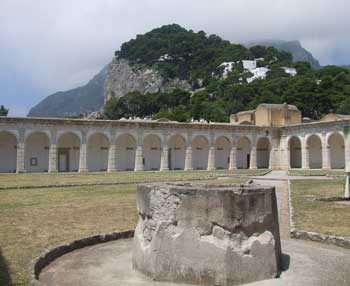
Of the few specific ‘sights’ in Capri, it is worth visiting the monastery or charterhouse, the Certosa di San Giacomo, which dates to the fourteenth century. There are two attractive cloisters and exhibitions of art including gloomy works by Karl Wilhelm Diefenbach. Entrance is free, but opening hours are limited. In the summer there are sometimes concerts and other events held here. Before you climb the lane back into the centre of town, investigate the dusty little park alongside the buildings, accessed by a path leading off the entrance-way. It has good views over the sea and the Faraglioni, as well as ruinous walls presumably associated with the Certosa.
A far more manicured little park can be found above the Certosa. The Giardini di Augusto are small gardens among rocks and trees with superb views of the Faraglioni. They are full of flowers – and tourists with whirring cameras – and are very picturesque. There’s a small admission charge, but it’s worth it for the flowers and the views. Usefully, there are public toilets (there’s a charge) close by, and along the lane is a good cheap stall selling granite in a range of fruity flavours including Capri lemon.
Excursions around Capri town
If it is not too hot a day, and you are happy to walk a couple of miles, there are several good excursions around Capri. One of our favourites is a walk around a picturesque stretch of coast. You should be prepared to spend an hour or more on the excursion, though there is the opportunity to stop for drinks or lunch. The walk begins by heading uphill from Capri town along Via Matermania, passing a convenient water tap where you can fill drinking bottles for the walk. A diversion on the right takes you past smallholdings to a wonderful viewpoint high above the sea; retrace your steps to join the main Arco Naturale route. When you reach the wooded cliffs, you can turn left past a restaurant terrace to descend steps to the a viewpoint by the Arco Naturale. This is an impressive natural rock arch high above the sea. Retracing your steps, you could pause at the restaurant – Le Grottelle – for a cold drink or a simple pasta lunch. Next you head down a long flight of steep steps to the Grotta di Matermania, a large cave containing ruins dating back to the Roman age, when the Emperor Tiberius may have used it as a space for entertaining. The next stretch of path winds along the steep slopes to Punta Tragara, above the Faraglioni. There are great views down to sea-level, where you can see the Casa Malaparte, a striking rationalist house designed for writer Curzio Malaparte (now belonging to a foundation). From Punta Tragara you can just stroll back into Capri town.
The Emperor Tiberius had several villas on Capri. The one with the most extensive remains is Villa Jovis, on the north-eastern corner of the island, with views over the sea and mainland. It is high on the cliffs and sources recount tales of unfortunates hurled down to their deaths at Tiberius’s command. The villa is just over a mile’s walk from Capri town, much of which is uphill. There’s a small entrance charge; the archaeological site is open from 9am until an hour before sunset. The ruins are quite overgrown, but still give you an idea of the scale of the palace and the luxury in which the Emperor lived.
In 2008 one of Capri’s most famous footpaths was reopened after years of closure. Via Krupp zigzags down steep cliffs from Capri town to Marina Piccola, at sea level. The impressively-engineered path was commissioned at the beginning of the twentieth century by Friedrich Alfred Krupp, a German industrialist who spent time on Capri before his fondness for the local boys caused a scandal in Germany which probably led to his death. At Marina Piccola there there are a couple of small public beaches and several fee-paying bathing establishments. There are also little orange buses back to Capri, so you don’t have to walk back uphill. Be warned that the seashore rocks below the path are sometimes visited by skinny-dippers.
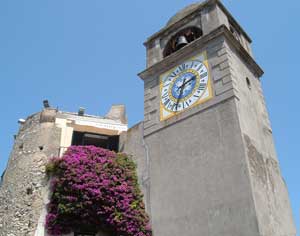
It is also possible to walk from Capri town down to Marina Grande, although most people take the funicular or bus. The busy port isn’t particularly charming, but there is a stretch of shingle beach as well as the possibility of hiring boats or taking an organised boat trip.
A zigzag road connects the island’s towns, and public buses run constantly up from Capri to Anacapri; a journey that takes around ten minutes. Once you have travelled to this higher part of the island there are many more walks and things to do and see. If you want to see the island, you should certainly explore further afield than Capri town.
> About Anacapri
Eating and drinking
Eating and drinking – for the rich and the unwary – is notoriously expensive in Capri. However, you don’t actually need to spend a fortune on the necessities of life in order to enjoy the island – here’s our advice for saving money on food and drink: Always check prices before sitting down,and note the cover charge (coperto) in restaurants. Unusually for Italy, most restaurants have huge mark-ups on their wines, and the more touristy places don’t offer an affordable house wine, so this is something to look for as you choose a restaurant. Be very careful about ordering drinks, antipasti or desserts off-menu without querying the price. There are a few little general stores, mostly on Via Le Botteghe, including a shop where staff will prepare you a decent roll for around 5. Further uphill, on Via Matermania, is a small supermarket (supermercato) where you can stock up on picnic provisions.
The one thing I would recommend splashing out on is an evening (or two) in the Piazzetta. Drinks are expensive at the cafe tables in the square, but they generally come with nibbles, and you can sit and relax for as long as you want, enjoy the night-time atmosphere and watch the fashion parade that is the Capri passeggiata.
Although Capri does have some good-quality restaurants and some restaurants with fantastic views, it’s hard to find an affordable combination of the two. For a cheap, decent meal in a crowded but friendly restaurant, we return to the Ristorante Longano ‘da Tarantino’ (Via Longano, 9). For an atmospheric meal out of town, you could try Le Grottelle, a restaurant built into a cave above the Arco Naturale. It has an outdoor terrace high above the sea, which is good for lunch – but if you’re visiting in the evening take insect repellent as the surroundings are leafy. Back in the heart of town, on a clear day there are good views of the Bay of Naples from the terrace of a restaurant called ‘Capri’s’ – but prices are tourist-level here. Da Gemma (Via Madre Serafina, 6) is one of the most popular eating places in town, and has panoramic windows with views over the island.
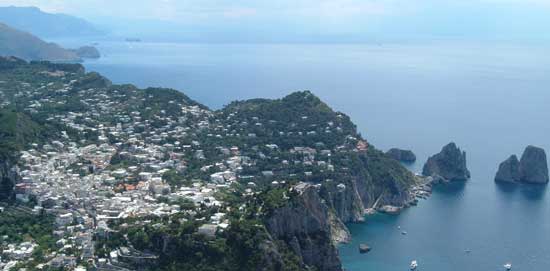
Accommodation
Capri is full of smart four and five-star hotels. These are obviously best-placed for appreciating the town, but some slightly cheaper options by the port in Marina Grande are convenient for arrival and departure. We have reviewed a good Capri four-star hotel and an economic alternative down by the sea in Marina Piccola, as well as picking out a selection of the best Capri hotels:
> Capri town hotels – our selection
On this site
Hotel ‘A Paziella, Capri town – our review
Hotel Weber Ambassador, Marina Piccola – our review
Useful external links